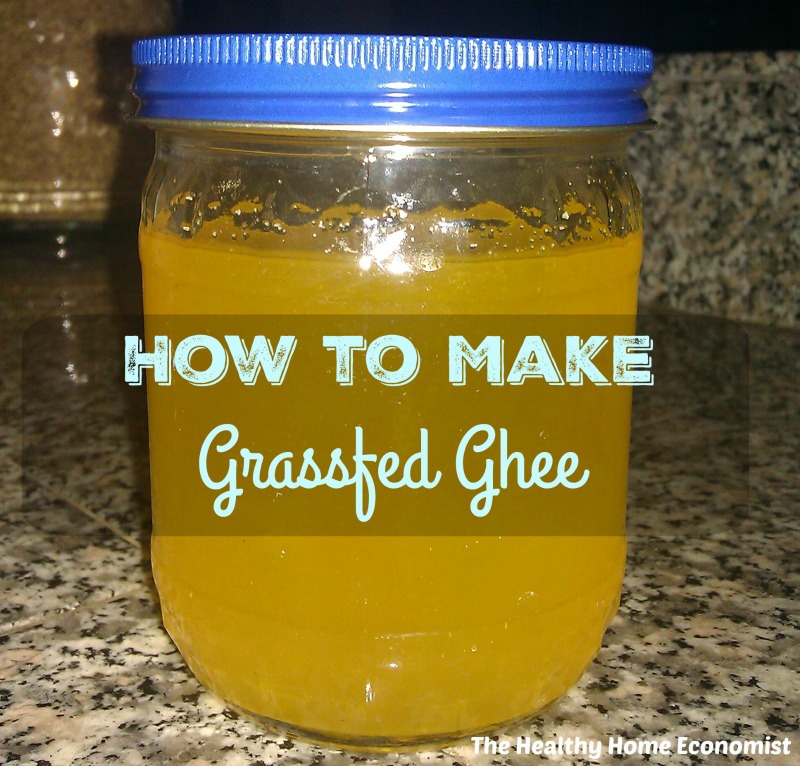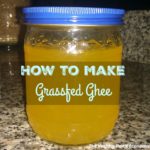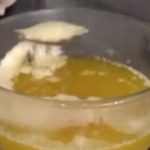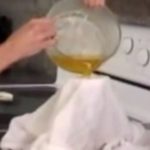Table of Contents[Hide][Show]
How to make homemade ghee on the stovetop quickly and easily for a healthy cooking fat that is shelf stable and nourishing.

Knowing how to make ghee is simply a must for any Traditional Cook. Clarified butter as it is also known, has been used for thousands of years by Indian cultures. In fact, traces of ghee have been found on fragments of Indian pottery dating as far back as 6500 BC!
When in a liquid state and made from unheated butter, ghee is called butter oil. Dr. Weston A. Price discovered that butter oil and cod liver oil work synergistically to supercharge absorption of Vitamins A, D, and K2 known as the X-factor.
Dr. Price always carried flasks of cod liver oil and butter oil to the bedside of very ill patients. More often than not, he was able to revive them with a few drops of each under the tongue. Using cod liver oil or butter oil separately did not have the same deathbed reviving effects.
Benefits of Ghee over Other Cooking Fats
It is best to know how to make clarified butter oil or ghee yourself rather than buying from the store. Notice the picture above of a jar that I made myself with pastured butter from a local farm. It is so yellow!
Commercial ghee from the store is a pale yellow, indicating lower nutritional value from cows eating grain mix instead of fresh green grass.
Ghee from the store is also ridiculously expensive, so learning to make it yourself is not only a more nutritious way to go, it is very cost-effective.
I make clarified butter oil for about half the cost of what it would be to buy it at the health food store.
Unlike butter, ghee does not need refrigeration and keeps well on the counter or pantry for many months. Keeping a jar in the pantry for a quick veggie saute is very convenient!
Another benefit of ghee is that it is easier to digest as all the milk solids (proteins) have been removed from the butter. Very frequently, even those with a true dairy allergy find that ghee presents no trouble for them.
Another advantage to using clarified butter instead of plain grass-fed butter is that the grassy taste and sometimes cheesy smell of the butter is eliminated.
Therefore, by learning to make clarified butter oil from grass-fed butter, you will find that you now have a healthy fat for cooking that does not displease your family with a cheesy odor. This can sometimes happen with grass-fed butter alone.
Homemade Grass-Fed Ghee
The recipe and video lesson below covers how to make this healthy and indispensable fat for use in your own kitchen.
I also cover how to make clarified butter capsules. This is a convenient way to take butter oil with your daily dose of cod liver oil.
If you are spending money on high vitamin cod liver oil (this is the brand I’ve used since 2015) it is a must to be taking it with clarified butter oil. This supercharges the beneficial effects!
Note that it is not advisable to make ghee from homemade raw butter. The heating process causes a loss of the enzyme and probiotics in this special food.
Prefer to Buy?
If after reviewing the recipe and video demo below you decide to buy instead, I would recommend this vetted source as a premier retailer of quality grass-fed ghee. Plain, cultured, and herb-flavored varieties are all available including a coconut oil/ghee blend.

How to Make Ghee
This simple recipe for making ghee can be accomplished on the stovetop in just a few minutes.
Ingredients
- 1 lb butter preferably grassfed and organic
- 1 wide mouthed mason jar quart size
- 1 cheesecloth fine mesh
- 1 funnel
Instructions
-
Place pound of butter in a medium sized pot or stove safe glass bowl. Turn heat on low and allow the butter to gently liquefy.
-
Turn heat to medium-low and gently remove foam that comes to the top of the melted butter with a slotted spoon.

-
After removing the foam, allow the melted butter to simmer on medium-low heat for 5-10 minutes longer to allow all the milk solids to settle out on the bottom of the bowl. You will know when the separation process is complete as the solids will be slightly brown on the bottom and the clarified butter will be completely clear and transparent.

-
Line a funnel placed into the open end of a wide mouthed mason jar with a fine mesh cheesecloth.
-
Pour the clarified butter into the funnel so that it is strained through the cheesecloth as it enters the mason jar.

-
Allow the finished ghee to cool in the mason jar. When room temperature, fasten the lid on tightly and store in the pantry as a convenient and incredibly healthy cooking oil for all your kitchen needs.








I’ve been reading your posts about curing cavities, and everything totally makes sense from a nutritional perspective. Just wondering if you could touch base on exactly the dosage of various things to take… What do you think of hypericum? Should it be taken to heal the nerve? I’ve had a terrible tooth infection, and the dentist put a temporary filling in but wants to do a root canal in 10 days. I feel that the body should heal the infection…. I’ve been on congaplex, cruciferous vitamins, immune boosters, etc., and I’ve been juicing with kale and broccoli and celery too. I would like to save the nerve. What is your advice?
Thank you so much for your video. Can you please tell me what kind of heating source did you use for making the ghee? is it directly on the stove?
Hi Sarah,
I was wondering what you thought about the capsulls that are a mix of fermented cod oil and butter oil? That is the only option at the health food store that I could find. I was going to purchase some online but between the two it would be almost $100 for both.
Great video on making butter oil! So I tried making some, following your instructions step by step. It took quite a while for the solids to go to the bottom and for it to become clear. Maybe 45 minutes. Did I not cook it high enough? Also it turned solid when it cooled. Is it suppose to remain a liquid?? Thanks for you help with this : )
Laura Lee
I wonder: would it work to skim the cream off homemade, raw milk kefir, make butter out of that and then ghee? Would that be considered fermented ghee??
Hi Sarah! i live/love your blog 🙂
i am lucky enough to get beautiful raw cream and milk from a local friend, grass fed only. i usually make butter in my blendtec but the other day i was showing my father how easy it is to make butter. he has a vitamix. as the cream whirled in the vitamix, it got warm (i forgot about that feature). i had one weird warm mess. i put back in mason jar in fridge to figure out what to do with it when i got home. after minutes the oil separated from the buttermilk, a bright yellow on top. it is not creamy like butter but very oily, just like my green pastures butter oil. what do you think? i washed it with cold water and will use it for cooking. the oil is much yellower than the butter i made. just wondering if anybody has any thoughts on this? i find it very interesting…..thank you!
Is butter from a cow that is pastured on fast growing grass, but still has some grains, still going to be as beneficial for healing teeth decay? Our cow is grass fed only, but we can’t seem to have any extra milk/cream for butter with our family of 10. However our neighbors make butter from their cow which is pastured, but also gets grain. We can get butter from them, but I’m wondering if any knows if it would be as good and have the needful vitamins/minerals to supplement our cod liver oil.
I believe true ghee is made when you basically burn the milk solids by boiling the butter for a while. It’s more for flavor, less for cooking. (Alton Brown)
Hi Sarah..
I am kind of new with this type of cooking. I was a vegetarian until two months ago..but it was not working for me and after some visits to the dentist I decided to give dense foods a go.
I made the guee from a butter I made with pasteurised cream…very tricky to find raw butter in the uk…affordable anyway…and when it cooled down it became solid again. Any thought about what I did wrong.
Thanks for all the great videos